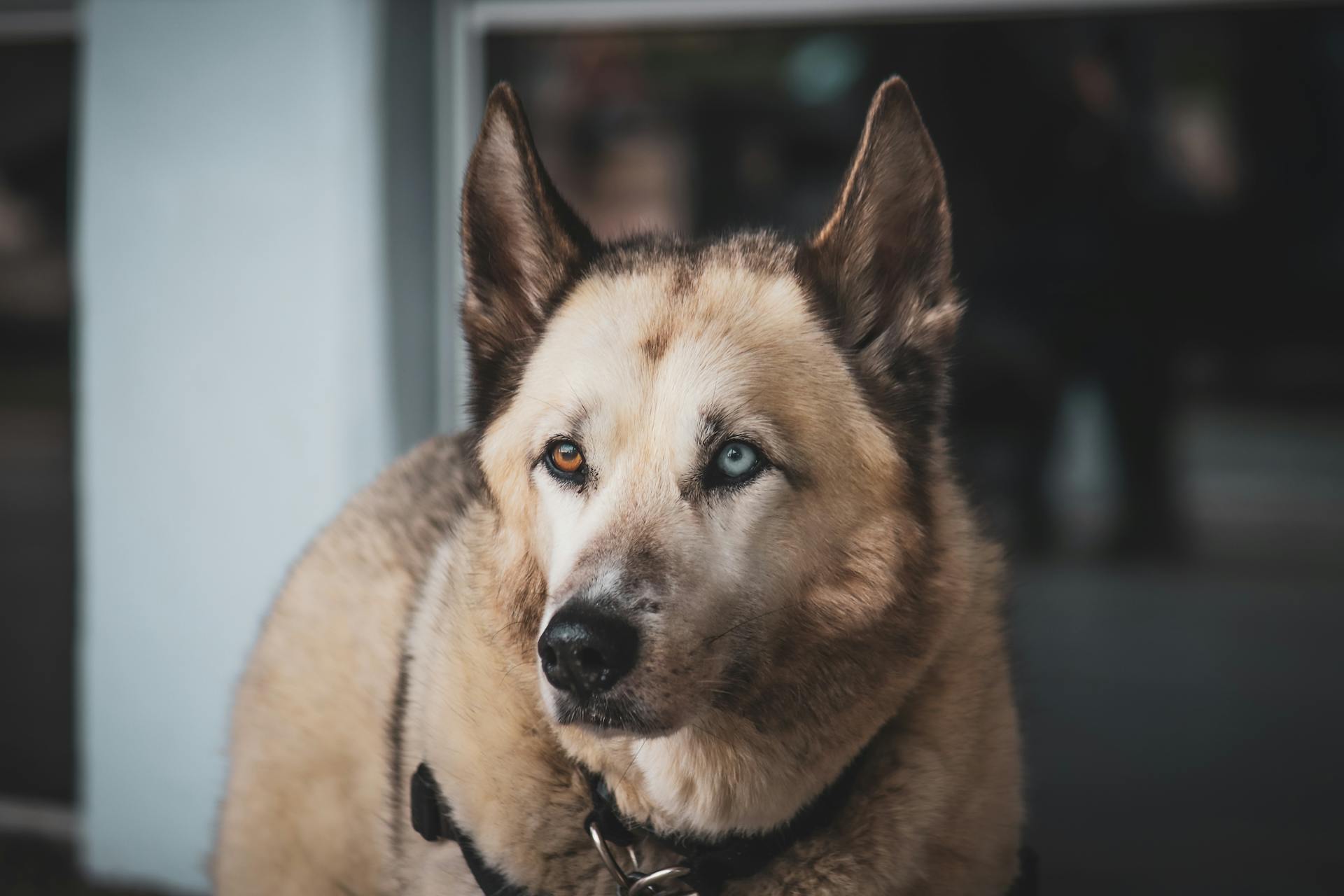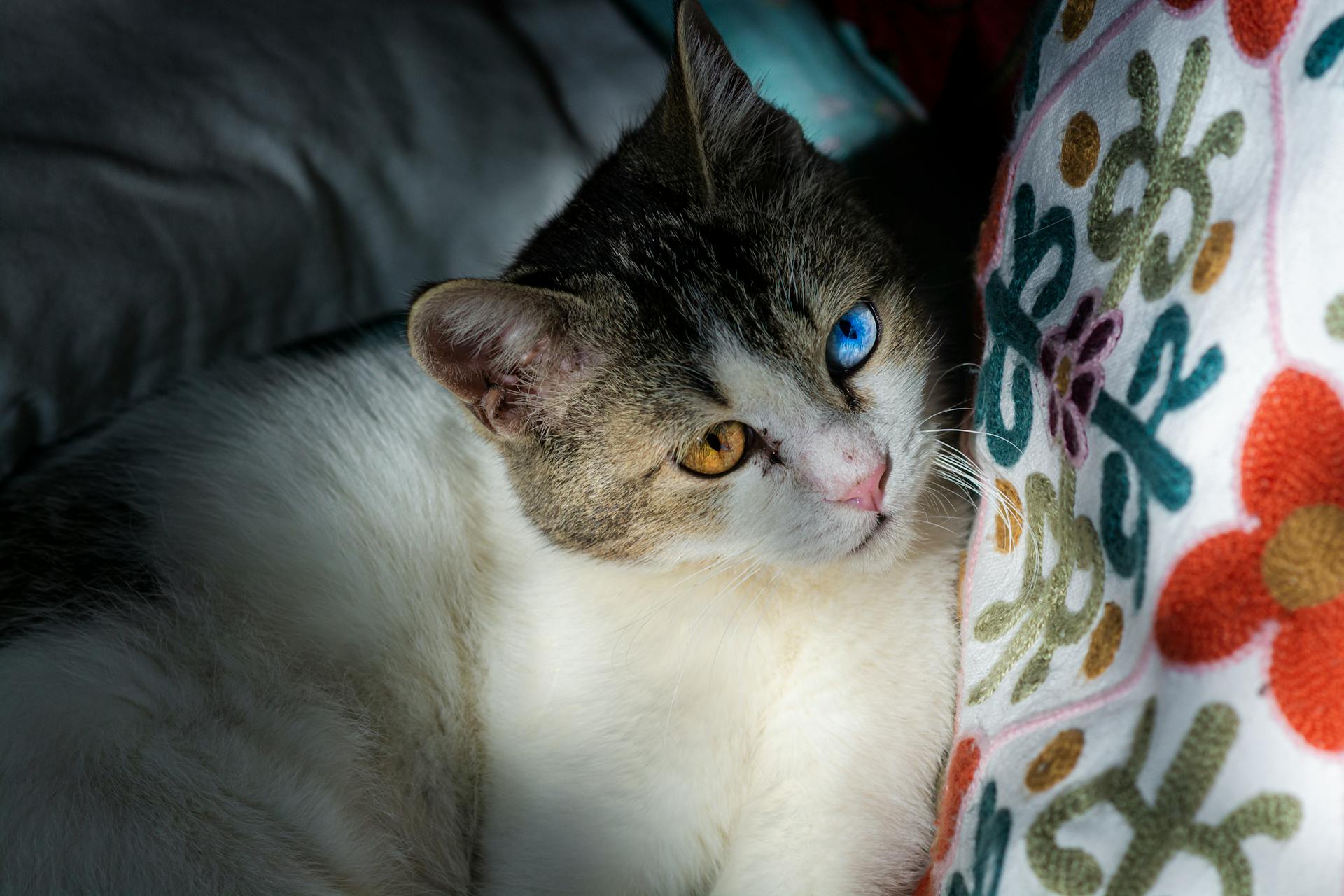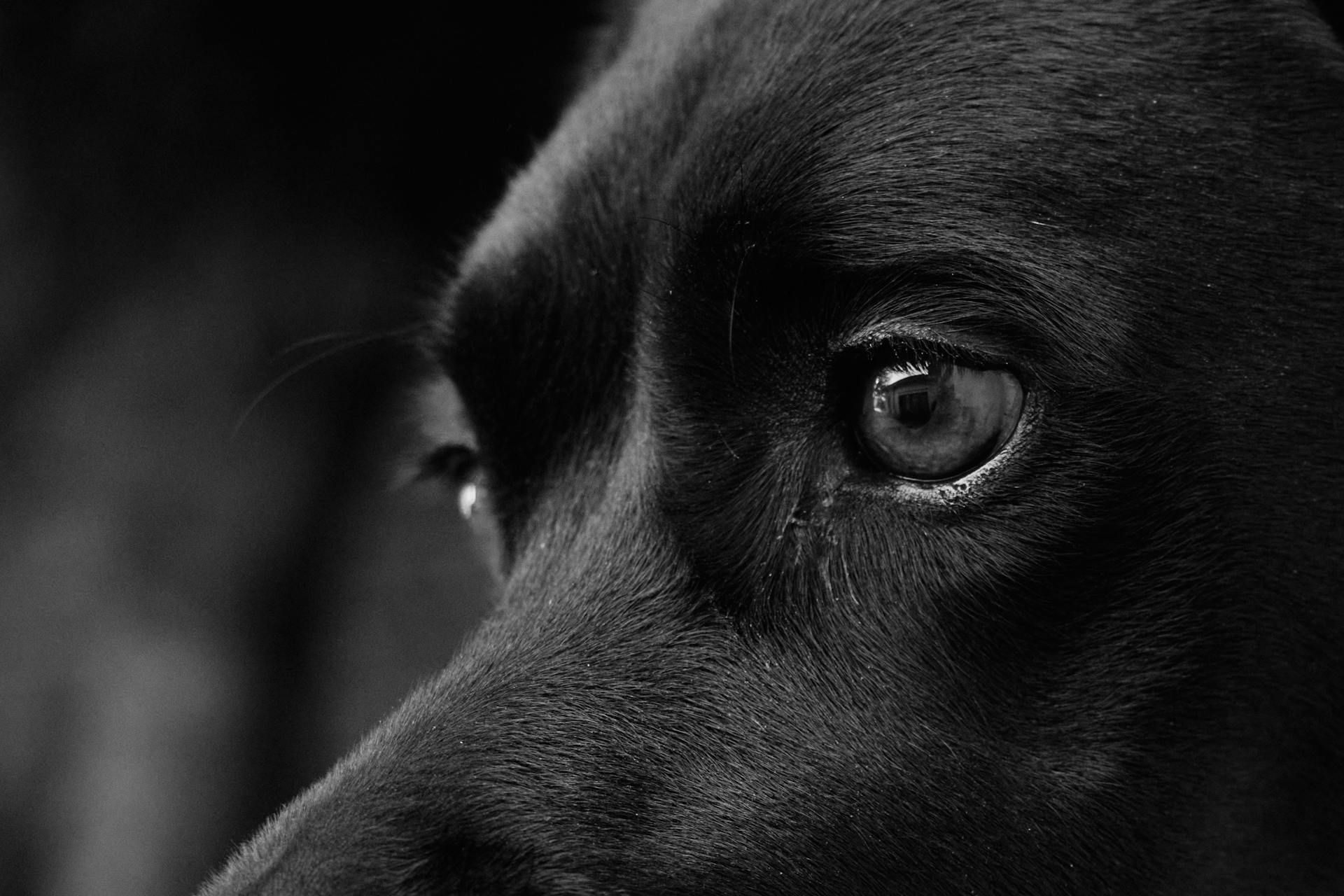
Dogs with two colors in one eye are a rare occurrence, but it's not unheard of. This phenomenon is known as heterochromia.
The exact cause of heterochromia is still not fully understood, but it's often linked to genetics and can be inherited from a dog's parents. Some breeds are more prone to heterochromia than others, such as the Dachshund and the Chihuahua.
In dogs, heterochromia can manifest in different ways, including sectoral heterochromia, where one eye has patches of different colors. This is often the result of a genetic mutation that affects the production of melanin, the pigment responsible for eye color.
What Is?
Heterochromia is a scientific term for two different-colored eyes.
It's caused by a lack of melanin pigmentation in the eye.
This condition can appear in dogs, cats, horses, and even sometimes people.
Hereditary heterochromia is often nothing to be concerned about.
However, if heterochromia is acquired later in life, it's often due to an injury or disease.
You should schedule an appointment with your veterinarian if you notice that your dog's eyes are changing color.
Causes and Types
Heterochromia in dogs can be caused by a variety of factors, including genetic and environmental influences.
Hereditary heterochromia is closely related to coat color and pattern, with dogs that are dapple, merle, white, or notably white around the head and eyes having a greater likelihood of having the condition.
There are three main types of heterochromia: Complete Heterochromia, where each eye is a different color; Sectional Heterochromia, where only a segment of the eye is a different color; and Central Heterochromia, where the center of one or both eyes is a different color than the outer parts of the eyes.
- Complete Heterochromia: This manifestation is where each eye is a different color.
- Sectional Heterochromia: This condition occurs when only a segment of the eye is a different color.
- Central Heterochromia: Central heterochromia occurs when the center of one or both eyes is a different color than the outer parts of the eyes.
Acquired heterochromia, on the other hand, is caused by external factors that permanently impact the color of the iris in affected dogs, such as inflammatory conditions, immune-mediated problems, certain medications, and injuries to the eyes and head.
What Causes Eye Colors?
Dogs with brown eyes have a large amount of melanin, while dogs with blue eyes have none in the stroma, the thickest part of the iris and the one that determines eye color.
The color of a dog's irises is determined by how much melanin is present in the eyes.
Dogs with heterochromia can have different amounts of melanin in each eye, or they may even have greater and lesser concentrations of melanin in different parts of the iris of the same eye.
Dogs with blue eyes have none in the stroma, the thickest part of the iris and the one that determines eye color.
In dogs, the amount of melanin in the eyes can vary greatly, leading to a wide range of eye colors.
For your interest: Shih Tzu Eye Color
Types
Heterochromia in dogs can manifest in different ways, and understanding these types can help us appreciate this unique trait. Complete heterochromia is one manifestation, where each eye is a different color, such as a rich brown hue and a striking shade of blue.
Dogs with complete heterochromia have distinctively different eye colors, which can be quite striking. Sectional heterochromia occurs when only a segment of the eye is a different color, like a brown eye with a section of bright blue in the iris.
If this caught your attention, see: Dog Coat Genetics

Central heterochromia, the third type, occurs when the center of one or both eyes is a different color than the outer parts of the eyes, creating a spiked or halo effect. This unique variation can add an extraordinary dimension to the dog's gaze.
Here are the three main types of heterochromia in dogs:
These types of heterochromia can be caused by a variety of factors, including genetic inheritance, eye-related injuries, or underlying health conditions.
Genetics
Genetics plays a substantial role in the development of heterochromia in dogs.
Inherited heterochromia can present in three different ways, making each dog's unique trait a result of genetic mutations or combinations.
Genetics is the most common underlying factor in the development of heterochromia in dogs, often resulting from genetic mutations that cause two different eye colors.
A dog may develop heterochromia if one of its parents has it or if it is a breed more susceptible to the phenomenon.
It's not uncommon for dogs to inherit heterochromia from their parents, making it a hereditary feature in some breeds.
Dogs with piebald or merle patterns are more likely to develop heterochromia, and females are more prone to it in certain breeds, such as Dalmatians.
Are Health Concerns Present?
Dogs with inherited heterochromia are not usually at a higher risk for other problems than dogs with the same colored eyes.
The exception is dogs with a merle pattern, which can lead to deafness and severe eye diseases.
Dalmatians with partial or sectoral heterochromia may have a higher risk of also being deaf.
If you notice any sudden color changes in your dog's eyes, they should see a veterinarian as soon as possible.
Color changes within the eyes can indicate injury, uveitis, glaucoma, clotting problems, cataracts, problems in the retina, the optic nerve, or corneal degeneration, among others.
Health conditions can influence eye color in dogs, and certain pre-existing conditions can contribute to changing eye color.
In some instances, the change in eye color is temporary, but depending on the underlying health problem or the severity of the condition, it could be permanent.
Heterochromia itself is not harmful to dogs, but it's essential to distinguish between heterochromia as a cosmetic trait and the underlying causes that may have led to it.
Regular eye check-ups and vigilance for any signs of discomfort or changes in eye health are crucial for responsible pet ownership.
Worth a look: Dog Eye Health Issues
Veterinary Examination

A veterinary examination is a crucial step in diagnosing heterochromia in dogs. This involves a thorough physical assessment of the dog's eyes.
The veterinarian will carefully observe both eyes, assessing the color, pupil size, and any signs of discomfort or inflammation. They'll be looking for any signs of injury or underlying health conditions that might be contributing to the heterochromia.
Gathering the dog's medical history is also essential. This includes information about any past injuries or ocular conditions, as well as the dog's breed and family history, which can provide insights into the potential genetic factors contributing to heterochromia.
The veterinarian may ask you questions about your dog's medical history, such as any previous eye problems or injuries. They'll also want to know about your dog's breed and family history to see if there's a genetic link to the heterochromia.
Here are the steps involved in the veterinary examination:
- Physical Assessment: The veterinarian will observe the color, pupil size, and any signs of discomfort or inflammation in both eyes.
- Medical History: The veterinarian will gather information about the dog's past injuries or ocular conditions, breed, and family history.
- Genetic Testing: In cases where heterochromia is suspected to be of genetic origin, the veterinarian may recommend genetic testing.
In most cases, heterochromia in dogs does not require specific treatment, as it is usually a benign and cosmetic trait.
Living with a Heterochromatic Dog
Heterochromia can occur in dogs of any breed, but certain breeds are more predisposed to this captivating phenomenon. These breeds include Australian Shepherd, Siberian Husky, Border Collie, and Dalmatian.
Regular eye check-ups are essential for dogs with heterochromia, as it can be a symptom of underlying health conditions or ocular disorders. If heterochromia is a result of an eye injury, the injury itself may require medical attention.
Caring for a dog with heterochromia involves being mindful of their unique eye care needs. Protection from excessive sunlight is also essential.
Here are some breeds that are more likely to inherit heterochromia:
- Australian Shepherd
- Siberian Husky
- Border Collie
- Dalmatian
While heterochromia itself is not harmful to dogs, responsible pet ownership entails vigilance for any signs of discomfort or changes in eye health.
Specific Breeds and Features
If you're wondering which dog breeds are more likely to have heterochromia, you're in luck because certain breeds are indeed more prone to this fascinating trait. These breeds include the Australian Shepherd, Siberian Husky, Border Collie, and Dalmatian.
Take a look at this: Green Eyed Dogs Breeds
While heterochromia can occur in any dog breed, it's more common in breeds with ocular color dilution. Some of these breeds include the Shih Tzu, Malamute, Old English Sheepdog, and American Cocker Spaniel.
In the case of Dalmatians, heterochromia seems to occur more frequently in female dogs. However, this isn't necessarily true for other breeds.
Here are some breeds that are more likely to have heterochromia:
- Australian Shepherd
- Siberian Husky
- Border Collie
- Dalmatian
- Shih Tzu
- Malamute
- Old English Sheepdog
- American FoxHound
- American Cocker Spaniel
It's worth noting that heterochromia can still occur sporadically in other breeds and mixed-breed dogs. This is because heterochromia is often a genetic trait that has been selectively bred over generations.
General Information
Dogs with two colors in one eye are a relatively rare phenomenon. This condition is known as heterochromia iridum.
Dogs can be born with heterochromia iridum or it can develop later in life due to injury or disease. It's a unique and fascinating trait that can add to a dog's individuality.
Heterochromia iridum can affect one or both eyes, and the colors can be in a variety of combinations, including blue and brown.
Cosmetic

Cosmetic heterochromia is a condition where a dog's eyes have different colors, but it's not caused by any underlying medical issue.
This type of heterochromia is purely cosmetic, meaning it doesn't affect the dog's health or well-being.
Dogs with cosmetic heterochromia can still lead happy and healthy lives, and their unique eye color is just one of their many adorable features.
No medical intervention is necessary for dogs with cosmetic heterochromia, so pet owners can simply enjoy their dog's one-of-a-kind look.
Readers also liked: What Are Dog's Favorite Color?
Pet Eye Color Variations
Heterochromia in dogs is a fascinating phenomenon where each eye sports a different color. This can be attributed to a variety of reasons, including genetic inheritance, eye-related injuries, or underlying health conditions.
Dogs with heterochromia can have different amounts of melanin in each eye, or they may even have greater and lesser concentrations of melanin in different parts of the iris of the same eye. This is because the color of a dog's irises is determined by how much melanin is present.
Suggestion: Chocolate Lab Eye Color
Some breeds are more predisposed to heterochromia, making it a striking feature in certain dogs. Certain breeds are more likely to exhibit heterochromatic eyes, providing valuable insights into this intriguing trait.
While heterochromia can be a sign of underlying health issues, it's essential to note that it's not always a cause for concern. Conditions affecting the eyes, such as glaucoma or uveitis, could alter iris pigmentation, but these are typically not signs of serious health problems.
In some cases, eye conditions that alter the clarity of the cornea or the eye may be mistaken for heterochromia, like glaucoma or cataracts.
Worth a look: Dog Eye Health
Frequently Asked Questions
Is it rare for a dog to have two different colored eyes?
Heterochromia, where a dog has two different colored eyes, is not rare and can occur in various breeds, including the Siberian Husky. However, it's still a unique and intriguing trait that's worth learning more about.
Sources
- https://www.mypawsitivelypets.com/2013/06/why-do-some-pets-have-different-colored.html
- https://www.greenfieldpuppies.com/blog/heterochromia-in-dogs/
- https://www.dogster.com/dog-health-care/dogs-with-different-colored-eyes-heterochromia-in-dogs
- https://www.petassure.com/maxscorner/causes-of-heterochromia-in-dogs-different-colored-eyes/
- https://blog.tryfi.com/heterochromia-in-dogs/
Featured Images: pexels.com


